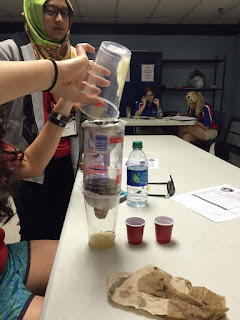In
May of 2015, Charles Bolden, a NASA Administrator, and participants at the Mars
Summit had a new mantra; “Mars Matters!”
Bolden went on to explain that Mars doesn’t just matter because it is
there, it matters because we can learn more about our planet through
discovering new things about Mars.
(Read the whole article
here)
Here’s a video with some inspiring
words and awesome graphics, showing what a trip to Mars might look like.
https://youtu.be/q7L8JiCxMDs
Needless
to say, Mars is the future of space exploration. In the coming decades, humans will launch new probes, rovers
and other equipment into the great unknown, headed for the fourth rock from the
Sun. In the 2020s, NASA
would like to launch and return a robot that would carry samples from the
surface of Mars back to Earth, for analysis.
Asteroid Redirect Mission
In
order to train Astronauts for a manned mission to Mars, in the 2020s, NASA will
redirect an asteroid into orbit around the moon. Astronauts will then use this asteroid as a training ground
for missions to Mars. This process
is known as the NASA Asteroid Redirect Mission.
I’m
going to be honest here and say that this whole asteroid redirect thing sounds
REALLY SKETCHY to me.
I never
imagined that someone would try and move an asteroid CLOSER to the Earth.
They’re all rocket scientists over
there, so I’m sure they’ve got it figured out.
They say it would burn up in Earth’s atmosphere, even if it
did approach us.
Still, that’s
definitely going to be a question I ask at Space Camp.
(Watch a video about the Asteroid
Redirect Mission
here.
It makes you feel a little better, so
maybe you won’t have nightmares.)
A Mission to Mars
The
goal of all of these missions is human exploration of Mars.
Getting there isn’t going to be easy,
though.
Mars is 300 MILLION MILES
AWAY.
Even if you’re going thousands
of miles per hour, it’s still going to take 6 months!
Also, since the oribits of Mars and Earth are different, the
rocket has to blast off from Earth and enter a “transfer orbit” towards Mars,
while the Earth continues on its own.
One false move and you’re forever flying away from your home
planet.
Good thing NASA scientists
are precise! (Watch a video about transfer orbits
here)
So,
what does it take to go to Mars?
Astronauts need at least a bachelor’s degree in engineering, biological science,
physical science, or mathematics, although an advanced degree is
preferred. They also need to have
experience in their field (science, technology or math jobs). Additionally, they must past a
physical to ensure that their body can handle the stresses of space travel.
So, You Want To Be An Astronaut....
The
average age of astronauts is 34, with the general range being between 26 and
46, although there are no set age restrictions. If you are 11 years old (hello, my fabulous fifth graders!)
you will be in the age range, starting in 2030 and you’ll be at prime astronaut
age in the year 2038.
Wait a minute…. That means…..
YESSSSSSS! You are the PERFECT age
to go to Mars!!!! I’m going to be wayyyy too old by then… but you… YOU can do
it! Let me say that I am extremely
jealous that you have the opportunity to go to Mars. If you want to make it happen, you now know the steps!
I expect to see a special “Thank
you to Mrs. Mason” in your pre-flight speech. You can tell them all about how some old lady was really
geeky and into space, but it made you a little interested in what YOU could do
to change the whole history of mankind. Forget about giant leaps, YOU CAN MAKE ENORMOUS
STRIDES! After all, you will be
traveling at over 12,000 miles per hour!
Ok space fans, this is my last
pre-camp blog. Wednesday
you’ll be seeing my blast off video. Get ready for ridiculousness, as I anticipate looking
like a fool at least once a day!
T-minus 6 days to camp!
P.S. Here’s a fun video that shows you how they build and
test rockets… it’s intense!
Ready to Rumble
























